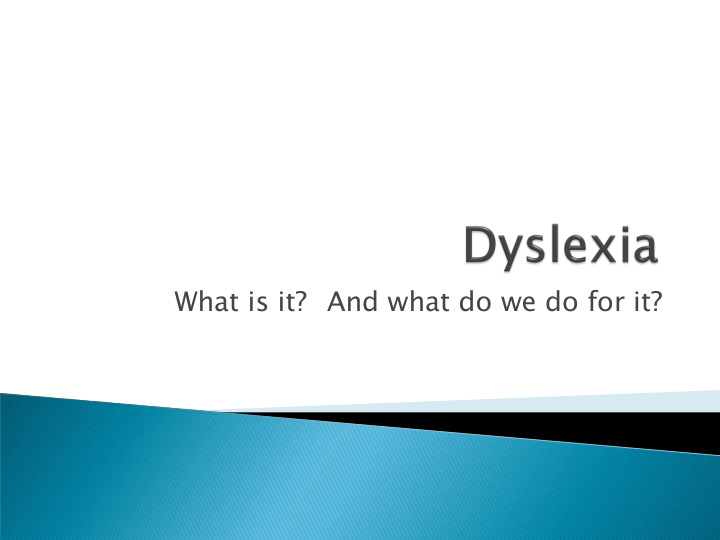



What is it? And what do we do for it?
Studied for the last 150 years Gone by many names: word blindness, minimal brain damage, “slow learner” 1921 Grace Fernald (UCLA ) publishes “Kinesthetic Spelling and Remedial Research” 1925 Dr. Samuel T. Orton studies 14 struggling readers and notes unusual characteristics
1936 Anna Gillingham (colleague of Orton) publishes “Remedial Training for Children with Specific Disability in Reading, Spelling and Penmanship” 1971-Isabelle Liberman (Yale) finds phonological processing as the underlying deficit in most reading disabilities 1990’s - Sally and Bennett Shaywitz (Yale) publishes “Overcoming Dyslexia” (2003); fMRI shows brain activity in good readers vs. struggling readers
Neuroscience of Reading From Overcoming Dyslexia-S. Shaywitz
Neuroscience of Reading
Dyslexia is a neurological-based, often familial disorder which interferes with the acquisition and processing of language. Varying in degree of severity, it is manifested by difficulties in receptive and expressive language, including phonological processing, in reading, writing, spelling, handwriting, and sometimes in arithmetic. Dyslexia is NOT the result of lack of motivation, sensory impairment, inadequate instructional or environmental opportunities, or other limiting conditions, but may occur together with these conditions. Although dyslexia is lifelong, individuals with dyslexia frequently respond successfully to timely and appropriate intervention.
Dyslexia is a specific learning disability that is neurological in origin. It is characterized by difficulties with accurate and/or fluent word recognition and by poor spelling and decoding abilities. These difficulties typically result form a deficit in the phonological component of language that is often unexpected in relation to other cognitive abilities and the provision of effective classroom instruction Secondary consequences may include problems in reading comprehension and reduced reading experience that can impede growth of vocabulary and background knowledge.
Federal ADA Law doesn’t specify “Dyslexia” State Education Codes use variety of terms DSM – IV (current term “Reading Disorders”) DSM-V (May, 2013, “Dyslexia”?)
Dys* lexia* “difficulty” + “words, language, reading” A specific language-based learning disability 80% of all reading problems Neurologic origin Hereditary
No single gene or chromosome Boys and girls equally Varies in degree of severity Occurs in all languages
Characteristics of Reading Slow, labored reading Ignores punctuation Difficulty sounding out words Tires easily May lose meaning of what they read
Characteristics of Reading Difficulty learning letters and sounds Misreads little words: does, from, goes Often adds sounds to words: bake / brake sip / slip Substitutes words with similar meaning: pad / bandaid house/home Word list vs. paragraphs
Characteristics of Reading MAY confuse p, b, d (not a vision problem) May mispronounce words: “flustrated”, “sheeprock”, “dylexia” May have difficulty with suffix endings MAY transpose letters: on vs. no HAS difficulty spelling (the hallmark of dyslexia)
MAY have: Word retrieval difficulties Poor memory for sequences Slower processing speed Difficulty with rote memorization (math facts, alphabet, months, names, etc)
Difficulty telling time and managing time Directionality difficulties : ◦ of letters ◦ left/right ◦ before/after ◦ ahead/behind Organizational problems “Good days” / ”bad days”
PA means difficulty perceiving sounds and syllables that make up words, and being able to store, retrieve and manipulate those sounds This weakness results in weak decoding skills Not a hearing acuity problem
Phonemic Awareness Skills Hearing parts of oral language : - segmenting sentences into words - words into syllables - syllables into sounds Discriminating between sounds Blending sounds together
Identifying sounds in a word Sequencing of sounds Sound deletion (What do you have if you take out the /p/ in /split/?) Rhyming
Phonemic Awareness - listening to and manipulating sounds. No text. Phonics matches sounds with letters and the rules governing the sounds the letters make. Phonics relies on strong phonemic awareness skills.
May include: History Cognitive functioning Language functioning Learning processes Academics
Is there a blood relation who also struggles with reading or been diagnosed with dyslexia? Are you right/left handed or mixed? Did you have special education in school? Full time, part of day, what grades? Resource?
(Give examples, demonstrate so they understand the task.) “How many syllables/claps in this word?” “How many sounds do you hear in this word?” “Give me a word that rhymes with _____.” “Tell me the sounds these letters make.” “Read these - they are not real words. “
Successful reading programs for dyslexics are: Systematic – teaches concepts in order and not leave to chance they will come up in text Explicit - teaches concepts directly Phonetic – teaches sound-symbol assoc and rules Multimodal – uses all the senses
Sequential A multisensory approach Combines reading, Key words for sounds writing and spelling Practice to automaticity Lots of reinforcement Simple to complex Structured
Wilson Reading System Language! Barton Reading and Spelling System Lindamood Instruction in Phonemic Segmentation (LIPS) emphasis on Phonemic Awareness
Word recognition (Phonics/Phonemic Awareness) Fluency Vocabulary Comprehension (see handouts for suggestions; also Teaching Adults Who Learn Differently: An Extensive Guide for Literacy Teachers and Tutors, L. Skinner, P. Gillespie, L. Balkam)
Extra time Exam Reader Learning Ally Books on tape College DSPS office
Kurzweil/Wynn Dragon Naturally Speaking Reading Pen Intel Reader E-Readers Apps
Videos: How Difficult Can This Be? Journey Into Dyslexia The Big Picture Could It Be Dyslexia? (avail. online at Bright Solutions for Dyslexia) Software: Reading Horizons Lexia’s Strategies for Older Students Earobics for Adolescents and Adults Ultimate Phonics Websites : see handout
Dyslexia • Not all people experience the same difficulties • Persists throughout lifetime • Compensate, not cure • Not contagious! • Has other strengths: spatial, music, art, math, big picture thinkers, higher level reasoning
Famous People With Dyslexia Henry Winkler John Irving Goldie Hawn Nelson Rockefeller Richard Branson Charles Schwab Winston Churchill Steven Spielberg (see You Tube dyslexia interview) Whoopie Goldberg Lt. Gov. Gavin Newsom
Recommend
More recommend